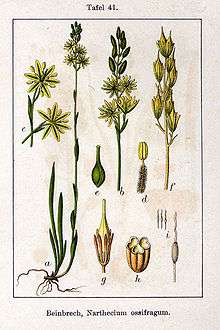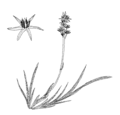Narthecium ossifragum
| Narthecium ossifragum | |
|---|---|
.jpg) | |
| Scientific classification | |
| Kingdom: | Plantae |
| (unranked): | Angiosperms |
| (unranked): | Monocots |
| Order: | Dioscoreales |
| Family: | Nartheciaceae |
| Genus: | Narthecium |
| Species: | N. ossifragum |
| Binomial name | |
| Narthecium ossifragum (L.) Huds. | |
Narthecium ossifragum, commonly known as bog asphodel,[1] Lancashire asphodel or bastard asphodel, is a plant of Western Europe, found on wet, boggy moorlands up to about 1000 m in elevation. It produces spikes of bright yellow flowers in summer. The bright orange fruits have been used as a colourant to replace saffron by Shetland Islanders.[2] Despite the plant's English name, it is not particularly closely related to the true asphodels.
The Latin specific name means "bone-breaker", and refers to a traditional belief that eating the plant caused sheep to develop brittle bones. The probable origin of this story is that sheep eating a calcium-poor diet are likely to develop bone weakness, and N. ossifragum favours acidic low-calcium soils.[2]
The plant can cause photosensitisation, a serious skin condition of sheep called alveld, "elf fire", in Norway. It can be relieved by moving stock into shade. Not all stands of the plant are toxic, and the toxicity may be the side effect of the plant's response to a fungal infection.[3][4][5]
It can be found in purple moor grass and rush pastures.
It is tufted, hairless perennial. The leaves are narrow.[6]
Gallery
.jpg) Narthecium ossifragum in flower
Narthecium ossifragum in flower N. ossifragum flower
N. ossifragum flower N. ossifragum fruiting
N. ossifragum fruiting N. ossifragum in fruit
N. ossifragum in fruit N. ossifragum, in situ near El Serrat, Andorra
N. ossifragum, in situ near El Serrat, Andorra- Narthecium ossifragum High Fens, Belgium
Illustrations
 Narthecium ossifragum
Narthecium ossifragum
Illustration in:
Jakob Sturm: "Deutschlands Flora in Abbildungen",
Stuttgart (1796) Narthecium ossifragum
Narthecium ossifragum
Illustration in:
Jakob Sturm: "Deutschlands Flora in Abbildungen",
Stuttgart (1796)
clean version Narthecium ossifragum
Narthecium ossifragum
Drawing by
Elly Waterman
| Wikimedia Commons has media related to Narthecium ossifragum. |
References
- ↑ "BSBI List 2007" (xls). Botanical Society of Britain and Ireland. Retrieved 2014-10-17.
- 1 2 Richard Mabey Flora Britannica
- ↑ Handbook of Plant and Fungal Toxicants by J. P. Felix D'Mello
- ↑ George B. B. Mitchell, 'Non-parasitic skin diseases of sheep' In Pract., Vol. 10, Issue 2, 69-73, March 1, 1988
- ↑ Arne Flåøyen, 'Studies on the aetiology and pathology of alveld'
- ↑ Sterry, Paul (2006). Complete British wild flowers. London: Collins. ISBN 978-0-00-720469-4.